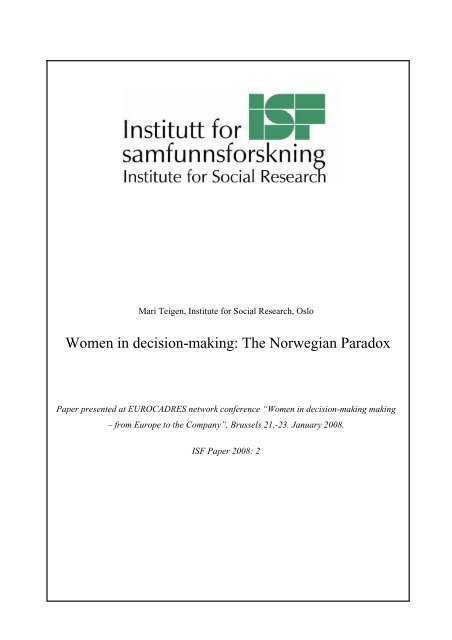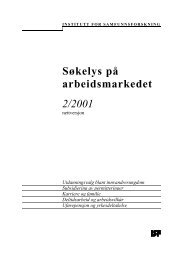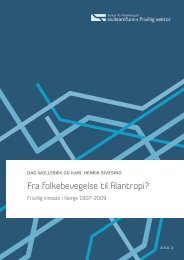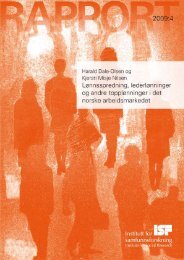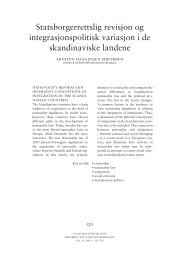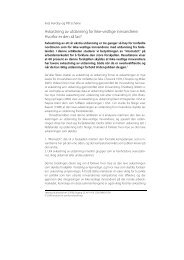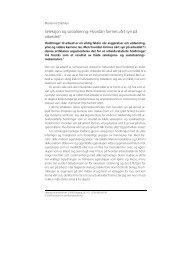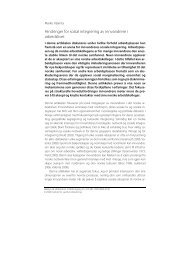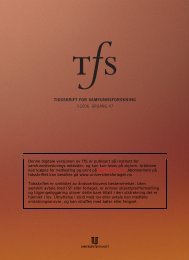Women in decision-making: The Norwegian Paradox
Women in decision-making: The Norwegian Paradox
Women in decision-making: The Norwegian Paradox
Create successful ePaper yourself
Turn your PDF publications into a flip-book with our unique Google optimized e-Paper software.
Mari Teigen, Institute for Social Research, Oslo<br />
<strong>Women</strong> <strong>in</strong> <strong>decision</strong>-mak<strong>in</strong>g: <strong>The</strong> <strong>Norwegian</strong> <strong>Paradox</strong><br />
Paper presented at EUROCADRES network conference “<strong>Women</strong> <strong>in</strong> <strong>decision</strong>-mak<strong>in</strong>g mak<strong>in</strong>g<br />
– from Europe to the Company”, Brussels 21.-23. January 2008.<br />
ISF Paper 2008: 2
Introduction<br />
In world-wide comparisons on gender equality the Nordic countries are regularly placed on<br />
top of the lists. This is the case when it comes to the number of women <strong>in</strong> political positions<br />
as well as broader aspects of gender equality such as economic opportunities, educational<br />
atta<strong>in</strong>ment, health and well-be<strong>in</strong>g for women and men. 1<br />
This fortunate situation <strong>in</strong> regard to gender equality is largely due to major<br />
transformations <strong>in</strong> gender relations that occurred <strong>in</strong> Norway throughout the 1970s and 1980s.<br />
<strong>The</strong> employment of women <strong>in</strong>creased dramatically and women got access to political <strong>decision</strong><br />
mak<strong>in</strong>g assemblies to almost the same degree as men.<br />
Still it is important to emphasize the ambiguities and paradoxes of the <strong>Norwegian</strong>, as<br />
well as for the rest of the Nordic countries, <strong>in</strong> relation to gender equality. On the one hand,<br />
processes of gender equality are a general trend. Female employment has <strong>in</strong>creased<br />
immensely, from less than half of the female population <strong>in</strong> the early 1970ties to about twothird<br />
today. Recently employment has <strong>in</strong>creased the most among mothers with small children.<br />
However, this is often not full-time employment. Statistics show that 40 % of all employed<br />
women work part-time and 12 % of all employed men. In spite of the gender differences, parttime<br />
work is more common <strong>in</strong> the <strong>Norwegian</strong> labour market, than <strong>in</strong> the rest of Europe. This<br />
is partly a consequence of high employment rates<br />
(http://www.ssb.no/english/subjects/00/02/10/ola_kari_en/arbeid_en/). Strong gender<br />
segregation is another important feature of the <strong>Norwegian</strong> labour market. Along the horizontal<br />
dimension, occupations and professions <strong>in</strong> the <strong>Norwegian</strong> labour market are strongly<br />
segregated by gender, and the gender segregated structures co-varies clearly with the<br />
1 Some examples of recent world-wide comparisons on gender equality are the World Economic Forum Gender<br />
Gap (2005) which rank Sweden first and Norway second on the list (http://www.weforum.org) and the United<br />
Nations Human Development Index (2002) which ranks Norway first and Sweden second (http://www.undp.org)<br />
(also when gender aspects are taken <strong>in</strong>to account see the GEM Gender empowerment measure and GDI Gender<br />
Related Development Index). <strong>The</strong> Inter-parliamentary Union provides statistics regard<strong>in</strong>g women <strong>in</strong> national<br />
parliaments (http://www.ipu.org). Currently (2005) Sweden is ranked as number two and Norway number three<br />
on the list.
public/private divide. <strong>Women</strong> dom<strong>in</strong>ate <strong>in</strong> public sector occupations and men <strong>in</strong> the private<br />
sector. Along vertical l<strong>in</strong>es, with some important exceptions, men dom<strong>in</strong>ate <strong>decision</strong> mak<strong>in</strong>g<br />
positions to a large extent (Teigen 2006).<br />
<strong>The</strong> ways <strong>in</strong> which the <strong>Norwegian</strong> society is featured by a mixture of gender equality<br />
and gender traditionalism <strong>in</strong> top-positions, will be addressed <strong>in</strong> this presentation. I will also<br />
<strong>in</strong>clude some reflections on the <strong>Norwegian</strong> tradition to adopt affirmative action and quota<br />
strategies to achieve gender equality, with special focus on the latest reform, the legal<br />
regulation of the gender composition of the boards of large jo<strong>in</strong>t stock companies.<br />
Politics<br />
<strong>The</strong> close to balanced representation of men and women <strong>in</strong> <strong>Norwegian</strong> politics has been the<br />
ma<strong>in</strong> symbol for the <strong>Norwegian</strong> gender equality achievements. In the <strong>Norwegian</strong> Parliament<br />
(Stort<strong>in</strong>get) women have occupied 37 percent of the seats – and it has been approximately so<br />
dur<strong>in</strong>g the last fifteen years. <strong>The</strong> proportion of women has been about the same among the<br />
cab<strong>in</strong>et of m<strong>in</strong>isters. Yet, at the moment <strong>in</strong> the red/green government established <strong>in</strong> 2005,<br />
there are <strong>in</strong> fact 10 women and 9 men <strong>in</strong> the cab<strong>in</strong>et. (Figure 1)<br />
In the municipal councils women are at an average represented with 36 %.<br />
Yet, also the political field offers important paradoxes of gender equality. In the<br />
national parliament the representation of women vary importantly between the political<br />
parties. On the one hand, close to gender balance characterizes the situation <strong>in</strong> the Labour<br />
Party (49 % women), <strong>in</strong> the Socialist Left party (47 % women), <strong>in</strong> the Christian Democratic<br />
Party (45 % women) and <strong>in</strong> the Liberal Party (40 % women). On the other, men dom<strong>in</strong>ate<br />
among members of parliament <strong>in</strong> the right w<strong>in</strong>g parties, the Conservative party (22 %<br />
women), and <strong>in</strong> particular <strong>in</strong> the Progress Party (16 % women). Hence, the election results <strong>in</strong><br />
2
egard to number of seats of the different parties <strong>in</strong> elected assemblies, affect importantly the<br />
gendered distribution.<br />
In the municipalities the situation is similar. <strong>The</strong> representation of women <strong>in</strong><br />
municipal councils varies significantly throughout the country, it varies along party l<strong>in</strong>es, and<br />
men dom<strong>in</strong>ate strongly the top political positions <strong>in</strong> the municipalities. Only 17 % of the<br />
mayors are women.<br />
Figure 1: <strong>Women</strong> members of Parliament, 1945 – 2005 (%).<br />
60<br />
40<br />
34<br />
36<br />
39<br />
36 36<br />
37<br />
24<br />
26<br />
20<br />
16<br />
5 5 5<br />
7<br />
9 8 9<br />
0<br />
1945 1949 1953 1957 1961 1965 1969 1973 1977 1981 1985 1989 1993 1997 2001 2005<br />
Figure 2: <strong>Women</strong> members of parliament per party (2005-2009) (%)<br />
3
80<br />
60<br />
47<br />
49<br />
45<br />
40<br />
36<br />
20<br />
27<br />
22<br />
16<br />
0<br />
Socialist P Labour P Centre P Christian<br />
Dem P<br />
Liberal Left P Conservative<br />
P<br />
Progressive<br />
P<br />
Variation <strong>in</strong> male-dom<strong>in</strong>ance <strong>in</strong> <strong>decision</strong>-mak<strong>in</strong>g<br />
As a part of the <strong>Norwegian</strong> “Power and Democracy Study” an extensive survey of<br />
<strong>in</strong>stitutional elite groups were carried out. About 2000 top leadership positions were<br />
identified, and the persons hold<strong>in</strong>g these positions were <strong>in</strong>terviewed. <strong>The</strong> survey revealed a<br />
strong male dom<strong>in</strong>ance <strong>in</strong> <strong>Norwegian</strong> leadership positions: on average men dom<strong>in</strong>ate 84<br />
percent of <strong>Norwegian</strong> elite positions, vary<strong>in</strong>g from close to gender balance <strong>in</strong> party politics to<br />
complete male dom<strong>in</strong>ance <strong>in</strong> top military positions. <strong>The</strong> tendency is that the closer to the<br />
sphere of politics, the more balanced representation of men and women. With one major<br />
exception, <strong>in</strong> the justice elite there is a surpris<strong>in</strong>g and overwhelm<strong>in</strong>g male dom<strong>in</strong>ance. In<br />
public adm<strong>in</strong>istration and academia about one fifth of the top positions are held by women. In<br />
the organizational and cultural elite the representation of women varies between 30 to 40 %.<br />
<strong>The</strong> organizational elite is featured by a significant gender divide; while women hold more<br />
than one third of top positions <strong>in</strong> the employees’ organizations, men dom<strong>in</strong>ate more than 90<br />
% of top positions <strong>in</strong> the employer’s organizations (see Skjeie and Teigen 2003, 2006).<br />
Figure 3: Men and women <strong>in</strong> <strong>Norwegian</strong> elite groups (2001) (%).<br />
4
Defense<br />
Bus<strong>in</strong>ess<br />
Church<br />
Justice<br />
Media<br />
Central Public Adm<strong>in</strong>istration<br />
Academia<br />
Organizations<br />
Culture<br />
Politics<br />
0 20 40 60 80 100<br />
Bus<strong>in</strong>ess<br />
<strong>The</strong> absence of women is very strik<strong>in</strong>g <strong>in</strong> economic <strong>decision</strong> mak<strong>in</strong>g. In the large private<br />
enterprises women constitute only 2 %, even <strong>in</strong> the publicly owned enterprises the situation is<br />
about the same, men dom<strong>in</strong>ate totally. This is however not a particular <strong>Norwegian</strong> situation.<br />
<strong>The</strong> current situation <strong>in</strong> the other Nordic countries is very similar. <strong>The</strong> number of women <strong>in</strong><br />
top-positions <strong>in</strong> the <strong>Norwegian</strong> as well as the Swedish bus<strong>in</strong>ess elite was only four percent. A<br />
correspond<strong>in</strong>g study <strong>in</strong> F<strong>in</strong>land, also from 2001, reveals exactly the same number; four<br />
percent women <strong>in</strong> the bus<strong>in</strong>ess elite. A current example from Denmark is that it is only one<br />
female CEO <strong>in</strong> the top 200 Danish firms (Christiansen and Togeby 2005).<br />
In all the Nordic countries the absence of women <strong>in</strong> economic <strong>decision</strong> mak<strong>in</strong>g has<br />
been widely debated. In Norway, a particular strand of this debate is about the possibility and<br />
fairness of legally regulat<strong>in</strong>g the gender composition of the boards of large bus<strong>in</strong>ess<br />
enterprises. However, before I approach the recent <strong>Norwegian</strong> regulation of the gender<br />
composition of corporate boards, I will give a brief <strong>in</strong>troduction to the role of affirmative<br />
action and quota policies <strong>in</strong> <strong>Norwegian</strong> gender equality politics.<br />
Figure 4: Men and women <strong>in</strong> the bus<strong>in</strong>ess elite <strong>in</strong> the Nordic countries (2000/01) (%).<br />
5
Denmark<br />
99<br />
F<strong>in</strong>land<br />
96<br />
Sweden<br />
96<br />
Norway<br />
96<br />
0 10 20 30 40 50 60 70 80 90 100<br />
Quotas – the <strong>Norwegian</strong> solution<br />
In comparison with the other Nordic countries, quotas and positive action procedures have<br />
played a particularly prom<strong>in</strong>ent role with<strong>in</strong> <strong>Norwegian</strong> gender equality politics (Borchorst<br />
1999). Throughout the last thirty years an extensive system of quota and positive action<br />
arrangements has been established <strong>in</strong> Norway. Positive action and quota procedures exist<br />
almost with<strong>in</strong> all fields of the society: education, employment, political and economic<br />
<strong>decision</strong> mak<strong>in</strong>g; and also <strong>in</strong> the private sphere, by the “father quota”, requir<strong>in</strong>g that at least 6<br />
weeks of the 44 weeks parental leave is reserved to the father.<br />
Positive action and quota arrangements differ from quite soft measures to strict quota<br />
demands. <strong>The</strong> exist<strong>in</strong>g positive action and quota arrangements can be divided <strong>in</strong>to three ma<strong>in</strong><br />
types: preferential treatment procedures, promot<strong>in</strong>g procedures and m<strong>in</strong>imum representation<br />
rules (see Teigen 2003, PhD dissertation partly published <strong>in</strong> English, Teigen 2002a, Teigen<br />
2006).<br />
Preferential treatment: In recruitment and promotions <strong>in</strong> the state, the municipal sector, <strong>in</strong><br />
some private companies, and <strong>in</strong> connection with admission to gender skewed types of<br />
6
education, applicants from the underrepresented gender are given priority, when qualifications<br />
are equal or about equal. Follow<strong>in</strong>g from the carefulness of the formulation of these<br />
procedures, they have proved to have only m<strong>in</strong>or direct effects. In spite of their relative<br />
efficiency, studies <strong>in</strong>dicate, however, that they affect organizations’ prioritiz<strong>in</strong>g and<br />
legitimiz<strong>in</strong>g of gender equality (Teigen 2002b).<br />
Promot<strong>in</strong>g procedures: A slightly different k<strong>in</strong>d of positive action procedures are promot<strong>in</strong>g<br />
procedures. <strong>The</strong>se k<strong>in</strong>ds of procedures imply that candidate’s chances are improved by be<strong>in</strong>g<br />
moved upwards <strong>in</strong> a prior ranked queue or row. <strong>The</strong> “additional po<strong>in</strong>t” system is the most<br />
commonly applied promot<strong>in</strong>g procedure, typically practiced <strong>in</strong> connection with admission to<br />
universities and colleges. A resembl<strong>in</strong>g, yet quite more effective, system is “earmark<strong>in</strong>g” of<br />
positions<br />
M<strong>in</strong>imum representation: Rules of m<strong>in</strong>imum representation set requirements for the gender<br />
composition <strong>in</strong> terms of fixed distributions – generally formulated as a demand for at least 40<br />
% of each gender. Pr<strong>in</strong>ciples of m<strong>in</strong>imum representation also exist as voluntary agreements <strong>in</strong><br />
the major <strong>Norwegian</strong> political parties, with the exception of the Conservative Party and the<br />
Progressive Party. In the Liberal Party, which was the first party to adopt quota procedures <strong>in</strong><br />
1974, the quota procedures is reserved the <strong>in</strong>ternal party system. <strong>The</strong> other four major parties<br />
have adopted quota arrangements <strong>in</strong> terms of both <strong>in</strong>ternal party quotas and candidate quotas:<br />
<strong>The</strong> Socialist Left Party <strong>in</strong> 1975; the Labor Party <strong>in</strong> 1983; the Centre Party <strong>in</strong> 1989; and the<br />
Christian Democratic Party <strong>in</strong> 1993 (Christensen 1999). In the organizational sector, mostly<br />
the voluntary organizations and the large employee organizations, quota systems for the<br />
composition of representative assemblies, are widely dispersed. In the largest of the<br />
employee’s organizations, the National trade union federation (LO), the <strong>in</strong>troduction of a<br />
7
quota system has however been a highly controversial issue. F<strong>in</strong>ally, a quota rule got a<br />
majority of the votes at LO congress <strong>in</strong> 2005.<br />
Legally regulated quota arrangements were however first <strong>in</strong>troduced <strong>in</strong> connection<br />
with the composition of publicly appo<strong>in</strong>ted boards, councils and committees (the Gender<br />
Equality Act, section 21, 1981). Recently the boards of publicly owned enterprises (from 1 st<br />
of January 2004) and large jo<strong>in</strong>t stock companies <strong>in</strong> the private sector (from 1 st of January<br />
2006/2008) are met by the same requirements, through a revision of the Company’s Act.<br />
Figure 5: Types of positive action/quota procedures accord<strong>in</strong>g to field of the society<br />
Field of society Types<br />
Education Preferential<br />
treatment<br />
Promot<strong>in</strong>g<br />
procedures<br />
Procedures<br />
Candidates of the underrepresented gender are given<br />
priority <strong>in</strong> cases of equal qualifications (same amount<br />
of school po<strong>in</strong>ts).<br />
Additional school po<strong>in</strong>ts granted to applicants of the<br />
underrepresented gender; earmark<strong>in</strong>g of<br />
school/student places for candidates of the<br />
underrepresented gender, with strict restrictions<br />
accord<strong>in</strong>g to qualifications.<br />
Employment<br />
Politics<br />
Publicly<br />
appo<strong>in</strong>ted<br />
boards, councils<br />
etc.<br />
Preferential<br />
treatment<br />
M<strong>in</strong>imum<br />
representation<br />
M<strong>in</strong>imum<br />
representation<br />
In recruitment and promotions applicants of the<br />
underrepresented gender are given preferential<br />
treatment when qualifications are equal or about<br />
equal.<br />
Quotas (at least 40 % of each gender) regulate party<br />
election lists and appo<strong>in</strong>tments with<strong>in</strong> party<br />
organisations <strong>in</strong> five out of the seven major political<br />
parties<br />
M<strong>in</strong>imum 40 % of each gender should be represented<br />
<strong>in</strong> publicly appo<strong>in</strong>ted boards, councils and committees<br />
Corporate boards M<strong>in</strong>imum<br />
representation<br />
M<strong>in</strong>imum 40 % of each gender should be represented<br />
<strong>in</strong> the boards of publicly owned enterprises and large<br />
jo<strong>in</strong>t stock companies <strong>in</strong> the private sector.<br />
8
Corporate Board Quotas<br />
As already mentioned, the legal regulation of the gender composition of corporate boards has<br />
been a central issue <strong>in</strong> the public debate <strong>in</strong> Norway for more than a decade.<br />
In December 2003 the <strong>Norwegian</strong> Company Act was revised, by support from the<br />
Conservative-Centre government coalition, the Labor Party and the Socialist Left Party. From<br />
2003 all publicly owned companies have to have at least 40 % of each gender <strong>in</strong> their<br />
corporate boards. While the large jo<strong>in</strong>t stock companies were allowed some time to make<br />
such hard demands possible. If they did not voluntary achieve the 40 % quota until July 2005,<br />
the legal demand of at least 40 % of each gender would also apply for them. By 1 January<br />
2008, all large jo<strong>in</strong>t stock companies must have at least 40% women <strong>in</strong> the boards.<br />
It is not an exaggeration to say that the adoption of legal regulations to secure about<br />
equal representation of men and women <strong>in</strong> the large jo<strong>in</strong>t stock has been controversial. No<br />
other country has <strong>in</strong>tervened <strong>in</strong>to the recruitment to top positions <strong>in</strong> a similar way. <strong>The</strong> quota<br />
procedure has however not only produced heated debate it has also produced major changes<br />
<strong>in</strong> the gender composition of corporate boards. At the time when the issue entered the public<br />
debate <strong>in</strong> the first part of the 1990ties, not even reliable statistics existed. <strong>The</strong> count<strong>in</strong>g of<br />
women <strong>in</strong> corporate boards <strong>in</strong>dicated they there were very marg<strong>in</strong>ally represented by no more<br />
than 2 to 4 % of the positions. Statistics from 2002 confirm that there were 6 % women <strong>in</strong><br />
corporate boards, 16 % <strong>in</strong> 2005, 30 % <strong>in</strong> 2007 and f<strong>in</strong>ally 36 % <strong>in</strong> 2008. Still, the gendered<br />
composition of boards varies to a large extent, and there are 91 companies that have not<br />
fulfilled the quota demands. So, the big issue today, is whether the government will sanction<br />
the companies that have not filled the quota requirements.<br />
9
Figure 6: <strong>Women</strong> <strong>in</strong> Corporate Boards (%).<br />
80<br />
60<br />
40<br />
30<br />
36<br />
20<br />
6<br />
11<br />
16<br />
0<br />
2002 2004 2005 2007 2008<br />
Accord<strong>in</strong>g to the Companies Act, a company that does not have a legal board, despite several<br />
warn<strong>in</strong>gs with the possibility of correct<strong>in</strong>g the matter will be subject to forced dissolution.<br />
<strong>The</strong> company board quota regulation is the result of a complex <strong>in</strong>terplay of political<br />
processes. <strong>The</strong> debates on the issue have been very heated. Still I would say that the<br />
impression is that it is more widely accepted today than when the debate sparked off. <strong>The</strong><br />
corporate board quota rule has to be understood <strong>in</strong> the light of a <strong>Norwegian</strong> gender equality<br />
self image, where the gender equality deficits of bus<strong>in</strong>ess life came to constitute a major and<br />
disturb<strong>in</strong>g problem. <strong>The</strong> boards, and not the hired management, were chosen as the impact<br />
area simply because this was where legal regulations could be imposed. Among owners and<br />
top bus<strong>in</strong>ess executives, women cont<strong>in</strong>ue to be almost unrepresented. A legal regulation of the<br />
gender composition of company boards were not chosen because this was considered to be the<br />
most important arena for the exercise of power <strong>in</strong> the private economy, but because this was<br />
the only place where regulations to change the gender composition could be imposed.<br />
10
Conclud<strong>in</strong>g remark<br />
F<strong>in</strong>ally, I will reflect upon how the <strong>Norwegian</strong> gender equality discourse handles the paradox<br />
of an extreme male dom<strong>in</strong>ance <strong>in</strong> formal positions of power and <strong>in</strong>fluence comb<strong>in</strong>ed with a<br />
strong commitment to equality values. <strong>The</strong> dom<strong>in</strong>ant discourse on elite levels of society<br />
portrays equality as a k<strong>in</strong>d of nationally encapsulated and largely harmonious common<br />
“journey”. <strong>The</strong> equality rhetoric claims that problems of gendered power are “almost solved”,<br />
that only “a few problems rema<strong>in</strong>s” before gender equality is actually “achieved”.<br />
Consequently the public debate is seldom concerned with issues of discrim<strong>in</strong>ation or other<br />
unpleasant matters. Gender equality is seen as a l<strong>in</strong>ear process where we all, together,<br />
cont<strong>in</strong>uously take new steps towards the goal. <strong>The</strong> goal can be “far ahead”, but still securely<br />
with<strong>in</strong> reach; we just have to travel for long and far enough. Gender equality is pasted <strong>in</strong>to a<br />
language of concerted action that creates cont<strong>in</strong>ued illusions of a change <strong>in</strong> “the right<br />
direction” happen<strong>in</strong>g all the time.<br />
<strong>The</strong> travel metaphor adds to the construction of a seem<strong>in</strong>g consensus on gender<br />
equality. Problems of <strong>in</strong>dividual and structural discrim<strong>in</strong>ation and misrecognition are simply<br />
bypassed. Gender equality is given a yield<strong>in</strong>g duty - as they conceal <strong>in</strong>formal power structures<br />
and hide the fact that equality often is a matter of concrete clashes of <strong>in</strong>terests and rights. <strong>The</strong><br />
public debate then becomes featured by what we have called the problem of benevolent noncommittal.<br />
Pr<strong>in</strong>ciples of gender equality often have to yield “a little”, and become politics that<br />
lack systematic priority. Rather the public debate is characterized by ad hoc <strong>in</strong>terventions and<br />
measures, not general, systematic efforts to achieve gender equality. Adopted measures<br />
appear as delimited <strong>in</strong>terventions. Thus, many of us will, with great excitement, follow the<br />
impact corporate board quotas, will have, both <strong>in</strong> relation to implementations and sanctions,<br />
and not the least if and how this may affect gender hierarchies of power and positions with<strong>in</strong><br />
bus<strong>in</strong>ess life, but also more broadly <strong>in</strong> relation to our understand<strong>in</strong>gs of gender, capital and<br />
power <strong>in</strong> society.<br />
11
Literature:<br />
Borchorst, Anette (1999), “<strong>The</strong> Gender Equality Mach<strong>in</strong>ery.” In Bergquist, Christ<strong>in</strong>a et al. Equal<br />
Democracies? Gender and Politics <strong>in</strong> the Nordic Countries. Oslo: <strong>Norwegian</strong> University Press.<br />
Christiansen, Peter M., and Togeby, Lise (2007), ”Elite Transformation <strong>in</strong> Denmark 1932-1999.“<br />
Comparative Social Research, Vol., 23, pp. 35-54.<br />
Christensen, Ann-Dorthe (1999), “<strong>Women</strong> <strong>in</strong> political parties”. In Bergquist, Christ<strong>in</strong>a et al. Equal<br />
Democracies? Gender and Politics <strong>in</strong> the Nordic Countries. Oslo: <strong>Norwegian</strong> University Press.<br />
Skjeie, Hege, 2003, Menn imellom. Oslo: Gyldendal.<br />
Skjeie, Hege and Mari Teigen (2005),”Political constructions of gender equality: ”Travell<strong>in</strong>g towards<br />
.......a gender balanced society”. NORA Nordic Journal of <strong>Women</strong>’s Studies. Vol. 13. No. 3, 187-<br />
197.<br />
Teigen, Mari, (2002a), “<strong>The</strong> Universe of Gender Quotas.” In NIKK-magas<strong>in</strong>, 4-11.Oslo: NIKK, <strong>The</strong><br />
Nordic Institute for <strong>Women</strong>’s studies and Gender research.<br />
Teigen, Mari (2002), “<strong>The</strong> suitable few: managerial recruitment practices <strong>in</strong> the <strong>Norwegian</strong> State<br />
Bureaucracy.” Scand<strong>in</strong>avian Journal of Management, 18 (2002), 197-215.<br />
Teigen, Mari (2006), “Die Norwegische Gender-Politik: Quoten und aktive Förderung” WSI-<br />
Mitteilung. (3) 138-143. 2006.<br />
Teigen, Mari (2006), Det kjønnsdelte arbeidslivet. En kunnskapsoversikt. ISF rapport 2006:002.<br />
http://www.samfunnsforskn<strong>in</strong>g.no/files/R_2006_2.pdf.<br />
12


